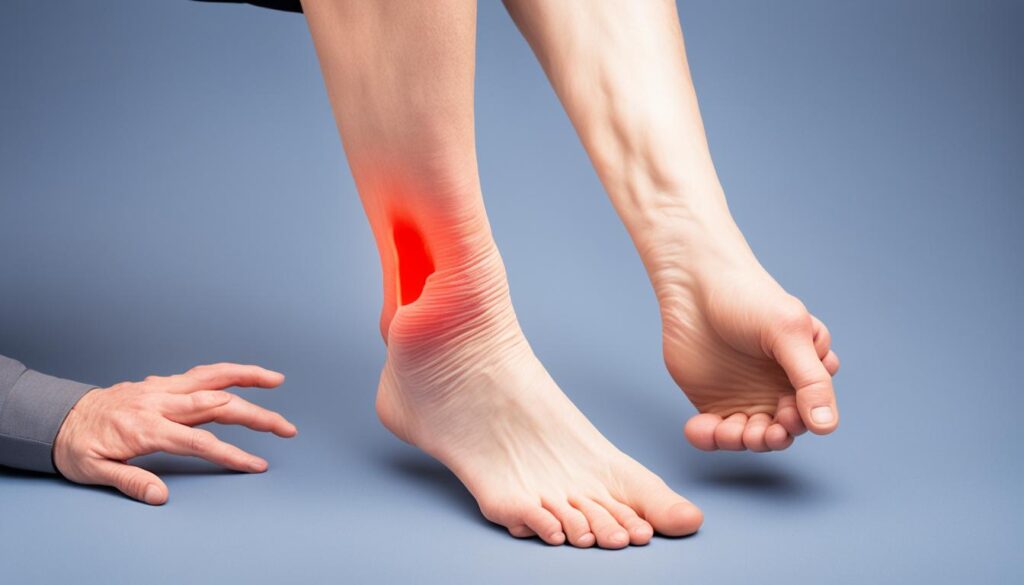Did you know nearly 80% of runners get hurt each year? It’s crucial to know how to avoid common running injuries. Sports medicine expert Dr. Alysia Robichau says most injuries are joint issues from overuse. These can happen from quickly increasing mileage, poor form, not enough recovery, tight or weak muscles, or bad shoes.
To avoid these injuries, runners should slowly increase their mileage. They should also use the right shoes and add stretches to their routine. These steps help muscles recover and improve running performance and longevity.
Key Takeaways
- A staggering 80% of runners face injuries each year, underscoring the importance of injury prevention.
- Most running injuries stem from overuse and improper running routines.
- Key prevention methods include planned progression, targeted recovery, proper footwear, and regular stretching.
- Sport medicine emphasizes that habitually tight or weak muscles contribute to common running injuries.
- Implementing strategic prevention habits can significantly enhance muscle recovery and running performance.
Understanding Runner’s Knee: Symptoms and Prevention
Runner’s Knee is a common problem for athletes and everyday runners. It happens when your kneecap doesn’t align right. This can lead to cartilage damage and a nagging pain in the front of your knee. Catching it early helps avoid more damage and keeps you running without pain.
What is Runner’s Knee?
Runner’s Knee causes pain around the kneecap, especially when you climb stairs or squat. It’s due to your kneecap not sitting right, which puts too much pressure on your knee. This issue can even trouble you when you’re sitting with your knees bent for too long.
Causes of Runner’s Knee
Several things can cause Runner’s Knee:
- Poor kneecap alignment
- Weak thigh muscles
- Suddenly doing a lot more activity
- Not wearing supportive shoes
These factors can harm your knee’s cartilage and lead to the common symptoms of Runner’s Knee.
Prevention Tips for Runner’s Knee
To prevent Runner’s Knee, consider these tips:
- Maintain proper running form: Good form keeps kneecap issues at bay.
- Incremental activity increase: Gradually up your running to avoid knee stress.
- Strength training: Work out your knee and hip muscles to support them better.
- Appropriate footwear: Choose shoes well-suited to your feet and running style.
Stick to these suggestions to avoid Runner’s Knee. This way, you can run healthier and without pain.
Identifying and Managing Shin Splints
Shin splints, known in the medical world as medial tibial stress syndrome (MTSS), is a problem that many athletes face. This condition causes pain in the lower leg due to overuse. Knowing how to spot and treat it is crucial for staying active and healthy.
Signs and Symptoms of Shin Splints
The pain from shin splints usually hits along the inner or front part of the shin bone. Activities make it hurt more, and the pain can be mild or very bad. It’s important to notice these pains early to avoid worse injuries.
Effective Treatments for Shin Splints
- Rest and Ice: Resting the leg and icing it can lessen the pain and swelling.
- Compression and Elevation: Compression wraps and raising the leg help lower swelling and discomfort.
- Orthotic Support: Wearing the right shoes and orthotic inserts can reduce stress on the shin.
Preventing Shin Splints
To prevent shin splints, start slow and boost your workout bit by bit. Adding strengthening exercises and choosing the right shoes are key steps. Warm up properly and keep your muscles in balance to stay clear of this overuse injury.
| Prevention Strategy | Description |
|---|---|
| Incremental Training Increases | Slowly increase workout intensity and time to protect your lower legs. |
| Muscle Strengthening | Add exercises that make your calf and shin muscles stronger. |
| Proper Footwear | Choose shoes that support your arch and cushion your steps. |
Plantar Fasciitis: What Runners Need to Know
Plantar Fasciitis is a frequent issue for runners, causing major heel pain. It makes daily activities hard. The pain comes from swelling of the plantar fascia. This is a tissue band at the bottom of your foot.
Understanding Plantar Fasciitis
The problem usually starts with repeated stress on the plantar fascia, especially from running injuries. Having tight calf muscles and high foot arches can make the swelling worse. This means more pain.
Common Symptoms
Severe heel pain is a key sign of Plantar Fasciitis. It’s worst after exercise or first thing in the morning. The pain can come and go and gets worse with a lot of standing or walking.
Prevention Techniques
Stopping plantar fasciitis starts with calf stretches to keep muscles flexible. This lessens tension on the plantar fascia. It’s also key to choose shoes that support and cushion your feet well. Keeping your workouts varied and active helps lower the chance of running injuries.

| Risk Factor | Prevention Technique |
|---|---|
| Tight Calf Muscles | Regular stretching exercises |
| Improper Footwear | Use shoes with proper arch support and cushioning |
| High Arches | Specialized insoles |
| Running Foot Injuries | Diversified workout routines |
Dealing with Achilles Tendinitis
Achilles Tendinitis causes pain in the Achilles tendon. It is common in runners. The pain is worse in the morning or after running.
This condition comes from using the tendon too much or putting too much stress on it. Tight calf muscles also make it worse.
To treat it, you should rest and use ice to lessen the pain and swelling. Stretching your calf muscles helps too. Slowly start running again to avoid making it worse.
Handling Achilles Tendinitis means dealing with the pain, avoiding overuse, and preventing injuries. Taking care of it properly and preventing it can keep runners doing their best without getting hurt.
Stress Fractures in Runners
Stress fractures are tiny yet painful cracks that appear in bones. They often affect runners’ shins and feet. These injuries usually come from too much training too soon. Taking action quickly when you first notice symptoms is key. It helps avoid more damage and ensures a safer recovery.
What are Stress Fractures?
Stress fractures are injuries showing small cracks in bones. Runners often face them due to repeating the same moves. They get worse if you don’t stop the activity and better with rest. This is why recognizing symptoms early is critical for anyone with ongoing lower limb pain.
Preventing Stress Fractures
There are key ways to prevent shin and other stress fractures. Runners should slowly up their training levels. It’s crucial to watch for overuse signs and include plenty of rest. Staying alert to how your body reacts to long runs can help. It ensures you train without harming your bones.
Managing Iliotibial Band Syndrome (ITBS)
Iliotibial Band Syndrome (ITBS) is a main cause of pain on the side of the knee. It often impacts people who run a lot. The IT band gets thick and rubs against the knee bone when they run too much. This problem can really affect a runner’s ability to do well.

To deal with IT band issues, taking it easy with exercise at first helps. Warming up before activities is very important. It gets the muscles ready and can prevent injuries. Stretching the IT band and nearby muscles regularly is also key to reducing friction.
After exercising, putting ice on the knee can ease pain and swelling. Using ice packs on the sore spot helps a lot. By doing these things, runners can better handle IT band problems. They can keep training with fewer issues.
Proper Running Form and Cross-Training for Injury Prevention
Adopting a proper running form and including cross-training can greatly lower injury risks for runners. This ensures they keep fit and healthy in the long run. Using different workouts not only betters running techniques but also balances the fitness routine. This balance helps work out different muscle groups.

Importance of Proper Running Form
It’s key to keep proper running mechanics to cut down injury risks. Things like how your foot hits the ground, your step length, and how you hold your body are vital. They help lessen pressure on joints and muscles. Running the right way means lining up your body correctly. This can be done by regularly checking and tweaking your form. Dr. Alysia Robichau says focusing on form can prevent injuries like shin splints and plantar fasciitis.
Benefits of Cross-Training
Adding different exercises to a runner’s plan has many pluses. Cross-training with activities like biking, swimming, and lifting weights makes fitness more varied. It works out different muscles and eases the repetitive strain that often causes injuries. This boosts heart health, strengthens muscles, and makes you more flexible. This all leads to being a stronger runner. Dr. Robichau suggests trying yoga and Pilates too. They help muscles recover, and increase core strength and balance. Both are important for good running techniques.
| Cross-Training Activity | Primary Benefits |
|---|---|
| Swimming | Low impact, full-body workout, improves cardiovascular health |
| Cycling | Strengthens lower body, enhances endurance without high impact |
| Strength Training | Builds muscle strength, supports joint health, promotes balance |
| Yoga | Improves flexibility, reduces muscle tension, enhances core stability |
| Pilates | Boosts core strength, enhances muscular endurance, supports posture |
Bringing these alternative exercises into your running plan increases fitness variety. It leads to better overall stability and lowers injury risks. Using a mix of exercises helps avoid the repetitive stress injuries often seen in running. This makes sure your fitness journey is lasting and fun.
Stretching Exercises to Prevent Running Injuries
Adding stretching to your routine is key for keeping muscles flexible and avoiding injuries while running. There’s some debate about stretching before you run. But it’s often recommended to warm up first with dynamic moves like high knees or squats. Then, move on to stretching exercises.
After running, stretching is crucial to help your muscles recover. It eases muscle stiffness and gets you ready for your next run. Here are some good stretches for runners:

- Hamstring Stretch: Ensures muscle flexibility and helps prevent hamstring strains.
- Quad Stretch: Targets the front of the thigh, integral for balanced muscle strength.
- Calf Stretch: Reduces the risk of Achilles tendinitis by loosening tight calf muscles.
- Hip Flexor Stretch: Enhances your range of motion and helps with stride efficiency.
- IT Band Stretch: Crucial for preventing lateral knee pain associated with ITBS.
Making these exercises part of your routine boosts muscle flexibility. This leads to safer and more efficient running. Make sure to do both a pre-run warm-up and a post-run cooldown. This way, your muscles are well-prepared for activity and properly taken care of after.
Conclusion
Keeping up with a good running routine takes careful effort. To avoid injuries, a well-rounded strategy is important. This means you should slowly increase your training, focus on recovery, use the right gear, and listen to your body.
Adding exercises that build strength, doing regular stretches, and mixing up your workouts help a lot. These steps keep your muscles balanced and flexible, lowering injury risks. Always pay attention to what your body tells you. If you feel constant or sharp pain, it’s time to see a doctor to dodge serious health problems.
Good running habits, paired with proper recovery, boost your performance and help you stay in the sport longer. By following these tips, runners can enjoy fewer injuries and a more rewarding experience. They’ll keep moving towards their health and fitness goals.


3 Comments
Submit a Comment